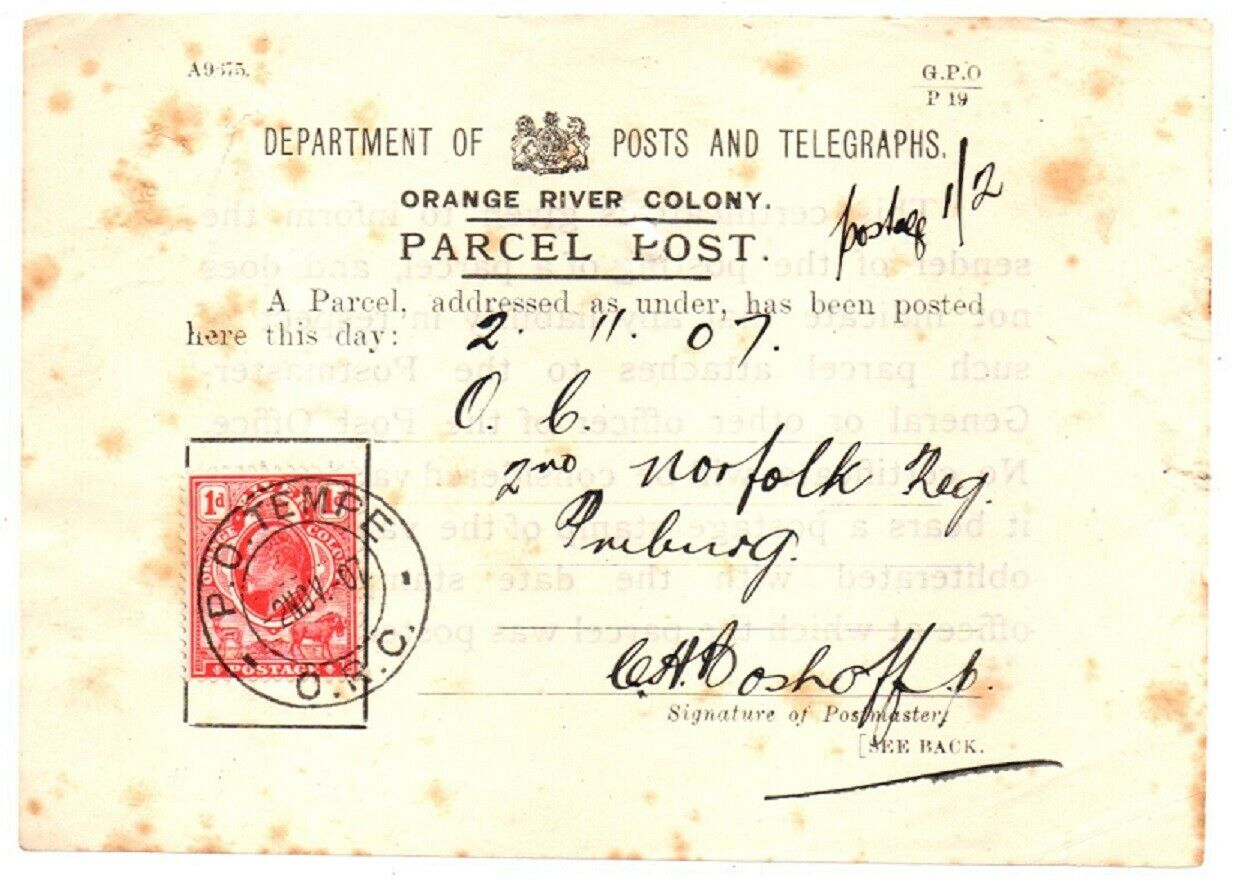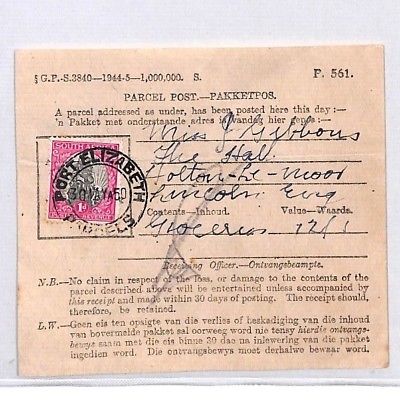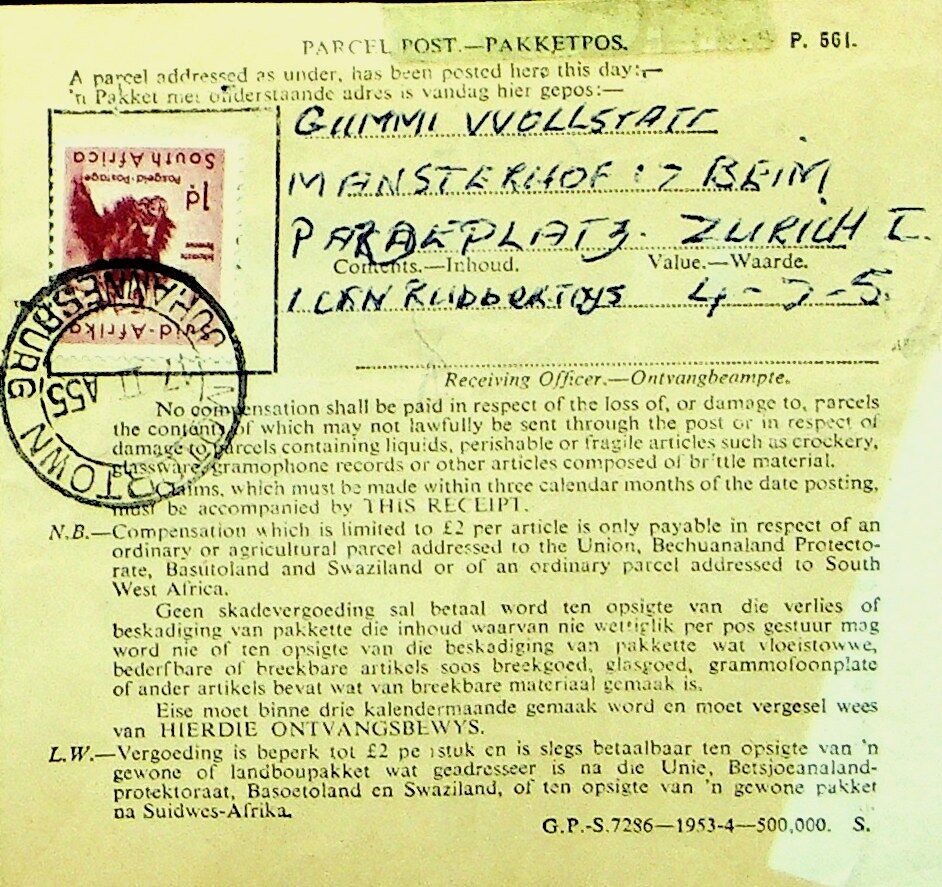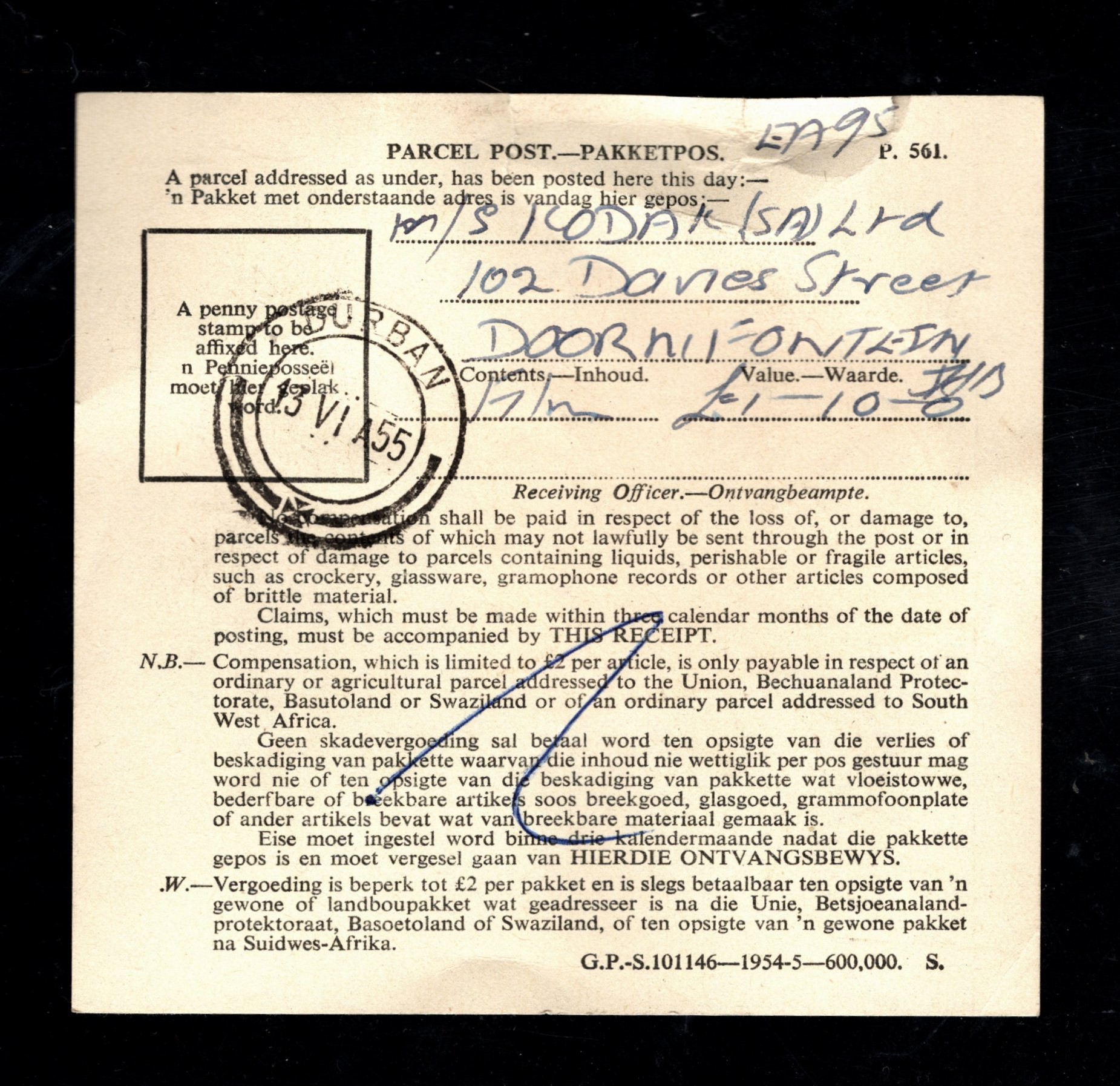Parcel Post Certificates used in Sir Lowry Road
Quote from Steve on January 9, 2024, 4:48 pmFor some years I have included a Parcel Post certificate (G.PO 598 /P.91. printed by V.A.R & Sons.) in my display of the "Postmarks of the Imperial Garrison, 1902 - 1914'. It confirms the posting of a parcel in the Sir Lowry Road post office addressed to the 'O.C. (Officer Commanding), 9 Lancers, Pstroom', (Potchefstroom), then the site of a large British Army Cantonment in the south-western Transvaal.
Struck with a neat example of the CoGH small single circle Sir Lowry Road datestamp, this certificate confirms that parcel S/2682 containing Stationery was posted on 'OC 17 07'. The certificate's reverse describes the limits on Postmaster-General's liability in respect of the parcel and its certificate. It states that the certificate was to "inform the sender of the posting of a parcel". (This certificate of posting cost the sender was 1d. This 1d rate for a proof of posting certificate would endure through the Union period up until the 1950s.)
The certificate records that the cost of posting the parcel was 'One Shg Five pence' (1/- 5d). Above the 'Signature of Postmaster' is the name of P. Warman. This created a belief that he was the Sir Lowry Road Postmaster. However, an examination of Franco Frescura's book, 'Postal Officials of the CoGH', finds no reference to a 'P. Warman' in Sir Lowry Road or indeed anywhere else. (Sadly, Frescura's book, based as it is on surnames, not towns, is of greater use to genealogists than it is to postal historians who, IMO, want to look up towns, not people.)
As my Parcel Post certificate drew admiring comments from some who saw it, and because it had a military purpose that connected it to the occupying Imperial Garrison who in the years after the SAW (South African War, 1899 -1902) maintained Pax Brittanica in a conquered and divided land, I set out to acquire a few more similar certificates. I now have four. These have led me to an interesting observation. All have been issued in the Sir Lowry Road post office and all are addressed to units of the British Army then occupying posts around South Africa.
These include:
Ordnance Officer, Port Elizabeth, CC. Fivepence on Stationery S/813. '12 JU 6'.
Officer Commanding, 97th Co., RGA, Simonstown, CC. Fivepence on Stationery S/1244. '23 AP 07'.
ADO SSA, A Hd Qrs, Pretoria. 'One Shg threepence' on Picketing Peg D/1213 'OC 26 07'.
All certificates have been paid for with a CoGH 1902 KE VII 1d carmine adhesive cancelled with the same small single circle single (8 - 4 o'clock) datestamp. According to Frescura's 'Post Offices and Postal Markings of the CoGH', this datestamp is first recorded used on '1 FE 1895' and last recorded on '28 NO 1908'. The Simonstown RGA (Royal Garrison Artillery) certificate includes an attractive piece of perforated gutter selvage. The certificates have been printed on two different papers, cream and grey, these being trimmed very slightly to different sizes.
The Castle, Cape Town, had tradtionally been the headquarters of the British Army in South Africa during the 19th century. This changed after the SAW when Cantonment Pretoria, renamed Roberts Heights on 1st June 1904, became the headquarters of British Forces in South Africa. Cape Town Castle was the headquarters of the South African (Imperial) Military Command. (A History of the SADF Institute (SADFI) 1916 - 1991. (Capt l.J. van der Waag. Scientia Militaria. 1919). These certificates provided the Castle's Imperial Military Command with, first, proof that their orders and or stationery had been mailed out and, second, a record of the cost of the parcel's postage in a time of military penny-pinching following the SAW's exorbitant cost.
The Big Question is why did the military in Cape Town Castle use Sir Lowry Road post office when the impressively modern GPO built in 1897 as the headquarters of the Cape Colony Post Office, stood on Adderley Street, just a brisk walk across the Grand Parade from the Castle's main entrance? The answer is probably that Sir Lowry Road was closer to the Castle and that it gave the Army preferential treatment also. I have failed to locate exactly where Sir Lowry Road post office was in 1906/07. It must have been in the road of the same name.
Imagine the following. You are in Cape Town. You are going to drive down Sir Lowry Road starting in Darling Street outside the City Hall. You drive out of central Cape Town in the direction of Woodstock, passing the Grand Parade on the left and the Drill Hall on the right. By the rear of the Castle on the left the road bends into Sir Lowry Road. Somewhere on this stretch of road between the Castle's rear and before it becomes Victoria Road, Woodstock, (served by Woodstock and Woodstock Station POs), must have stood Sir Lowry Road PO.
In the early 1980s I had a PO Box in Sir Lowry Road post office. This was an ugly glazed red brick building built in the same style as the Receiver of Revenue's Office behind the City Hall. In 1982 this Sir Lowry Road PO stood on the mountain side of the road just beyond the underpass of the Eastern Boulevard. This was further to walk than the GPO on Adderley Street. If convenient proximity was the reason why the British Army in the Castle used Sir Lowry Road PO it had to be sited closer to the Castle than my 1980s branch.
My distances assume that one would exit from the main gate of the Castle. That makes the GPO just one block away across the Parade. Sir Lowry Road PO would have been around the corner at the back of the Castle and somewhere undefined down the road. But, what if .... there was a back door to the Castle? Or due to space constraints in the 17th c. Castle, its administrative work took place in a nearby building. This would make Sir Lowry Road PO closer, especially if it were located near to the start of Sir Lowry Road.
I have been told that these Parcel Post certificates are uncommon. Accompanying one of my purchases was colour print showing the ADO SSA certificate of 'OC 26 07'. It claims that "The only known early examples [of this certificate] are the few receipts from the Sir Lowry Road correspondence". Do you have examples of these CoGH Parcel Post certificates that have been used elsewhere?
For some years I have included a Parcel Post certificate (G.PO 598 /P.91. printed by V.A.R & Sons.) in my display of the "Postmarks of the Imperial Garrison, 1902 - 1914'. It confirms the posting of a parcel in the Sir Lowry Road post office addressed to the 'O.C. (Officer Commanding), 9 Lancers, Pstroom', (Potchefstroom), then the site of a large British Army Cantonment in the south-western Transvaal.
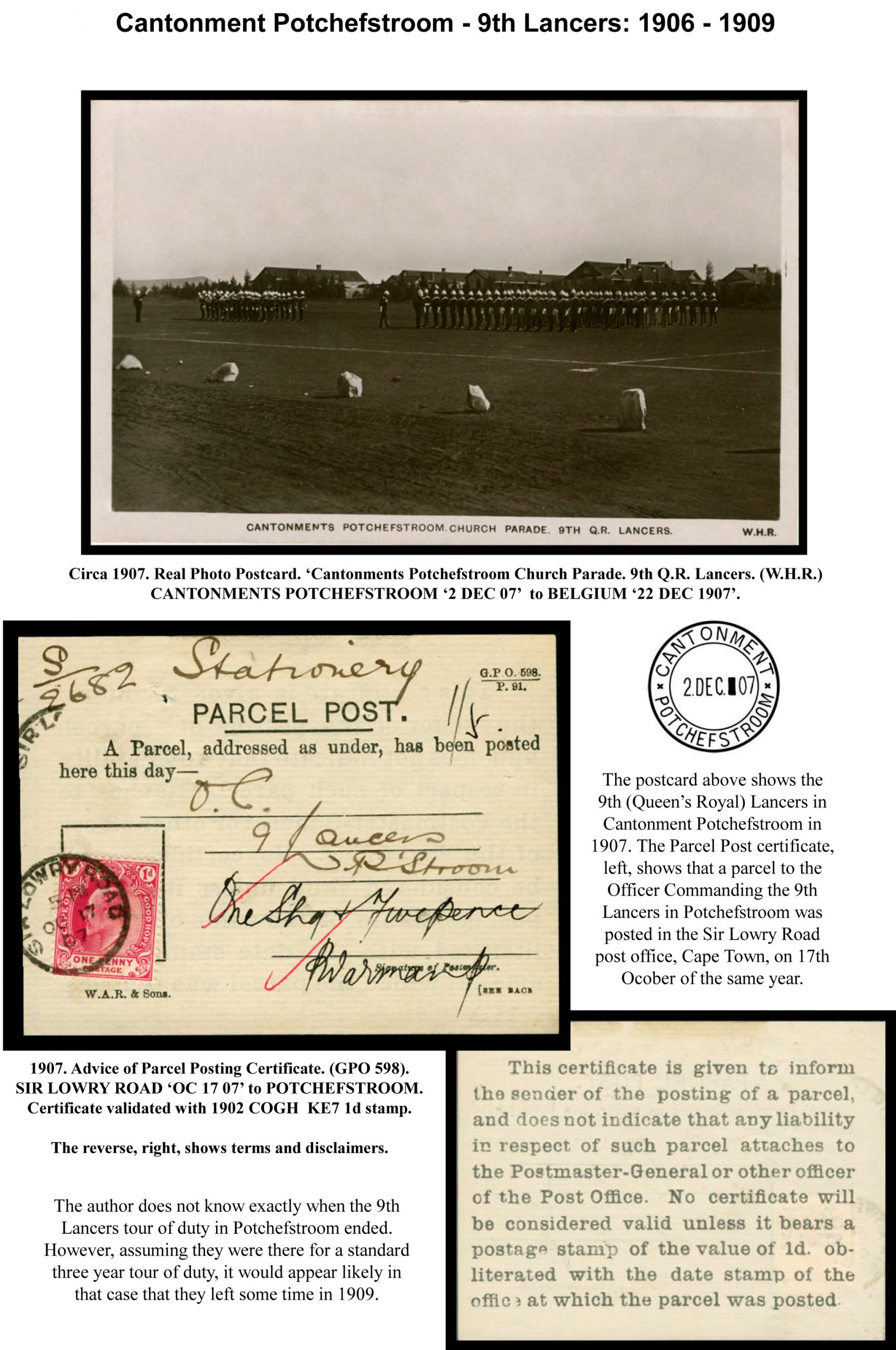
Struck with a neat example of the CoGH small single circle Sir Lowry Road datestamp, this certificate confirms that parcel S/2682 containing Stationery was posted on 'OC 17 07'. The certificate's reverse describes the limits on Postmaster-General's liability in respect of the parcel and its certificate. It states that the certificate was to "inform the sender of the posting of a parcel". (This certificate of posting cost the sender was 1d. This 1d rate for a proof of posting certificate would endure through the Union period up until the 1950s.)
The certificate records that the cost of posting the parcel was 'One Shg Five pence' (1/- 5d). Above the 'Signature of Postmaster' is the name of P. Warman. This created a belief that he was the Sir Lowry Road Postmaster. However, an examination of Franco Frescura's book, 'Postal Officials of the CoGH', finds no reference to a 'P. Warman' in Sir Lowry Road or indeed anywhere else. (Sadly, Frescura's book, based as it is on surnames, not towns, is of greater use to genealogists than it is to postal historians who, IMO, want to look up towns, not people.)
As my Parcel Post certificate drew admiring comments from some who saw it, and because it had a military purpose that connected it to the occupying Imperial Garrison who in the years after the SAW (South African War, 1899 -1902) maintained Pax Brittanica in a conquered and divided land, I set out to acquire a few more similar certificates. I now have four. These have led me to an interesting observation. All have been issued in the Sir Lowry Road post office and all are addressed to units of the British Army then occupying posts around South Africa.
These include:
Ordnance Officer, Port Elizabeth, CC. Fivepence on Stationery S/813. '12 JU 6'.
Officer Commanding, 97th Co., RGA, Simonstown, CC. Fivepence on Stationery S/1244. '23 AP 07'.
ADO SSA, A Hd Qrs, Pretoria. 'One Shg threepence' on Picketing Peg D/1213 'OC 26 07'.
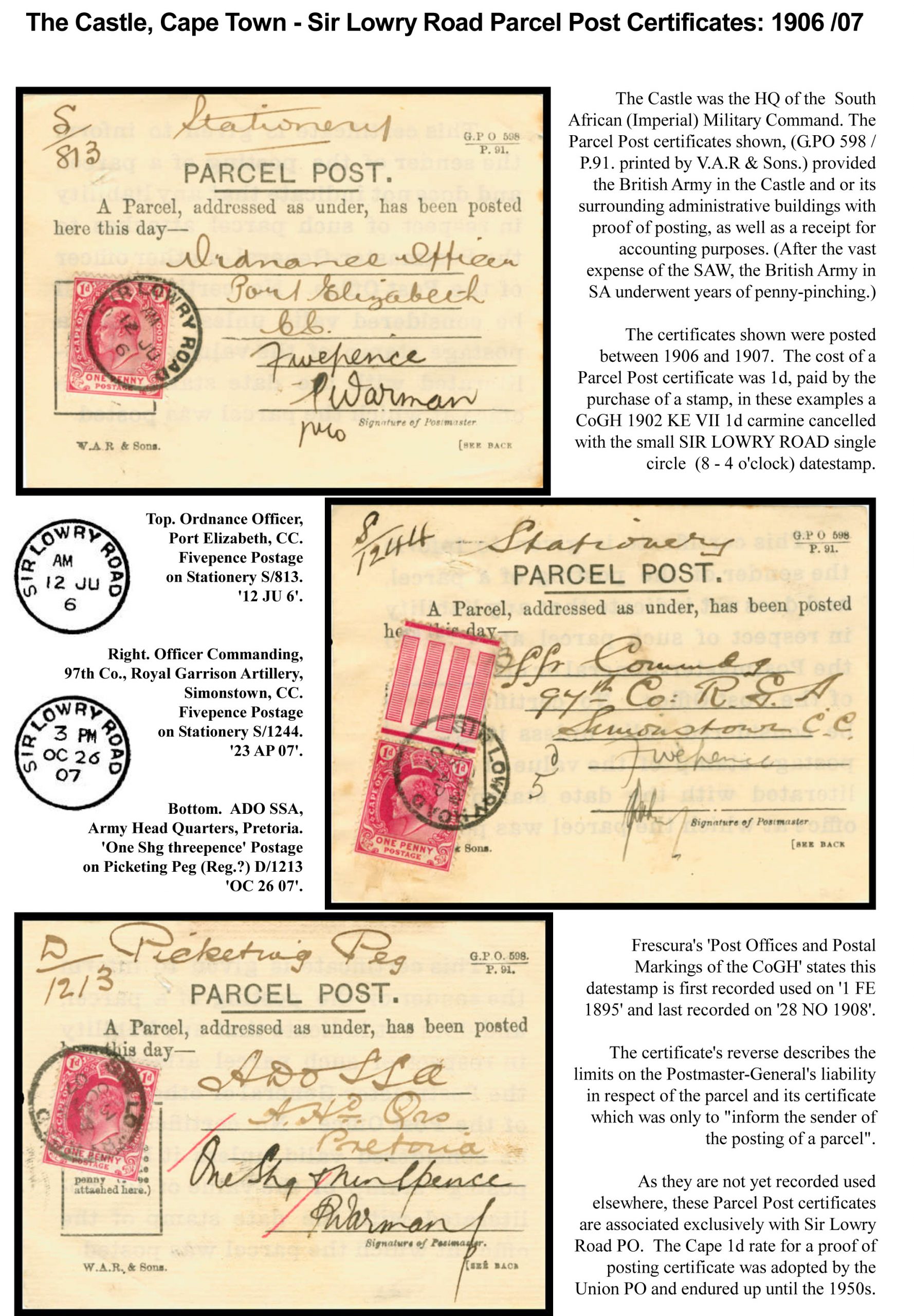
All certificates have been paid for with a CoGH 1902 KE VII 1d carmine adhesive cancelled with the same small single circle single (8 - 4 o'clock) datestamp. According to Frescura's 'Post Offices and Postal Markings of the CoGH', this datestamp is first recorded used on '1 FE 1895' and last recorded on '28 NO 1908'. The Simonstown RGA (Royal Garrison Artillery) certificate includes an attractive piece of perforated gutter selvage. The certificates have been printed on two different papers, cream and grey, these being trimmed very slightly to different sizes.
The Castle, Cape Town, had tradtionally been the headquarters of the British Army in South Africa during the 19th century. This changed after the SAW when Cantonment Pretoria, renamed Roberts Heights on 1st June 1904, became the headquarters of British Forces in South Africa. Cape Town Castle was the headquarters of the South African (Imperial) Military Command. (A History of the SADF Institute (SADFI) 1916 - 1991. (Capt l.J. van der Waag. Scientia Militaria. 1919). These certificates provided the Castle's Imperial Military Command with, first, proof that their orders and or stationery had been mailed out and, second, a record of the cost of the parcel's postage in a time of military penny-pinching following the SAW's exorbitant cost.
The Big Question is why did the military in Cape Town Castle use Sir Lowry Road post office when the impressively modern GPO built in 1897 as the headquarters of the Cape Colony Post Office, stood on Adderley Street, just a brisk walk across the Grand Parade from the Castle's main entrance? The answer is probably that Sir Lowry Road was closer to the Castle and that it gave the Army preferential treatment also. I have failed to locate exactly where Sir Lowry Road post office was in 1906/07. It must have been in the road of the same name.
Imagine the following. You are in Cape Town. You are going to drive down Sir Lowry Road starting in Darling Street outside the City Hall. You drive out of central Cape Town in the direction of Woodstock, passing the Grand Parade on the left and the Drill Hall on the right. By the rear of the Castle on the left the road bends into Sir Lowry Road. Somewhere on this stretch of road between the Castle's rear and before it becomes Victoria Road, Woodstock, (served by Woodstock and Woodstock Station POs), must have stood Sir Lowry Road PO.
In the early 1980s I had a PO Box in Sir Lowry Road post office. This was an ugly glazed red brick building built in the same style as the Receiver of Revenue's Office behind the City Hall. In 1982 this Sir Lowry Road PO stood on the mountain side of the road just beyond the underpass of the Eastern Boulevard. This was further to walk than the GPO on Adderley Street. If convenient proximity was the reason why the British Army in the Castle used Sir Lowry Road PO it had to be sited closer to the Castle than my 1980s branch.
My distances assume that one would exit from the main gate of the Castle. That makes the GPO just one block away across the Parade. Sir Lowry Road PO would have been around the corner at the back of the Castle and somewhere undefined down the road. But, what if .... there was a back door to the Castle? Or due to space constraints in the 17th c. Castle, its administrative work took place in a nearby building. This would make Sir Lowry Road PO closer, especially if it were located near to the start of Sir Lowry Road.
I have been told that these Parcel Post certificates are uncommon. Accompanying one of my purchases was colour print showing the ADO SSA certificate of 'OC 26 07'. It claims that "The only known early examples [of this certificate] are the few receipts from the Sir Lowry Road correspondence". Do you have examples of these CoGH Parcel Post certificates that have been used elsewhere?
Quote from Bas PAYNE on January 9, 2024, 6:48 pmSteve:
I've seen several other examples of Cape parcel post certificates (P.91) posted from Sir Lowry Road in the same period 1906-7, and no other Cape certificates.
I've seen one example of a similar ORC certificate (P.19), and attach a scan - again the parcel was sent to a military recipient, and posted from an office with strong military connections (Tempe).
I've also seen several later certificates - all from the 1945-1955 period, and attach scans of three examples. None of them are military - some are for films sent to processing labs, one is for "groceries" sent to the UK, and one for toys sent to Switzerland. The main additional point of interest is that they include (top left) details of the print order, including the numbers of labels printed - in the examples I've seen, the print orders were for 500,000, 600,000 and 1,000,000 labels. This suggests that lots of these labels were used, but that survival was very low and sporadic - most certificates of this kind would have been thrown away as soon as receipt of the parcel had been confirmed unless, as you have suggested for the Sir Lowry Road labels, there was an additional reason for keeping them.
Steve:
I've seen several other examples of Cape parcel post certificates (P.91) posted from Sir Lowry Road in the same period 1906-7, and no other Cape certificates.
I've seen one example of a similar ORC certificate (P.19), and attach a scan - again the parcel was sent to a military recipient, and posted from an office with strong military connections (Tempe).
I've also seen several later certificates - all from the 1945-1955 period, and attach scans of three examples. None of them are military - some are for films sent to processing labs, one is for "groceries" sent to the UK, and one for toys sent to Switzerland. The main additional point of interest is that they include (top left) details of the print order, including the numbers of labels printed - in the examples I've seen, the print orders were for 500,000, 600,000 and 1,000,000 labels. This suggests that lots of these labels were used, but that survival was very low and sporadic - most certificates of this kind would have been thrown away as soon as receipt of the parcel had been confirmed unless, as you have suggested for the Sir Lowry Road labels, there was an additional reason for keeping them.
Uploaded files:
Quote from Steve on January 10, 2024, 12:00 pmMany thanks for the advice and the expansion of this post.
Your ORC Parcel Post Certificate from Tempe would be very much at home (or in the barracks?) in my 'Postmarks of the Imperial Garrison' display. The Tempe postmark is common but the ORC Parcel Post certificate is NOT! This is the first one I have seen.
You confirm the use of other Parcel Post certificates in Sir Lowry Road but record none used elsewhere. Is it possible that these Parcel Post certificates were introduced by the Cape PO (and ORC) for use by the military? This may be how the British Army liked to record posted items elsewhere, specifically in GB. Perhaps military regulations and procedures demanded a similar service in SA? Perhaps a British collector of Victorian / Edwardian military mail can confirm the British Army's use of Parcel Post certificates in the UK - and elsewhere?
It strikes me that if these Parcel Post certificates were paid-for and retained as part of a system of military record-keeping. They must have come onto the postal history market at roundabout or after the time that the records were abandoned as surplus to requirements, probably after the start of WW1 when the Imperial Garrison was withdrawn from SA for service in Europe. When WW1 concluded there was a British suggestion that the Imperial Garrison could return to SA in 1919 but Smuts said no, the Union could look after itself. I wonder who rescued and kept these CoGH Parcel Post certificates? It was possibly during some clear-out in the Castle or nearby
Your three later, non-Sir Lowry Road Union era certificates confirm my statement that the 1d rate for a Parcel Post certificate remained in use until the mid 1950s. I take your point about the size of the print-run and the absence of surviving examples. I did look to see if these CoGH Parcel Post certificates included the number printed but they do not, nor does your OCR military example. Readers should note that often postal stationery like this has the numbers printed appear on the item. See Bas's last three certificates.
Many thanks for the advice and the expansion of this post.
Your ORC Parcel Post Certificate from Tempe would be very much at home (or in the barracks?) in my 'Postmarks of the Imperial Garrison' display. The Tempe postmark is common but the ORC Parcel Post certificate is NOT! This is the first one I have seen.
You confirm the use of other Parcel Post certificates in Sir Lowry Road but record none used elsewhere. Is it possible that these Parcel Post certificates were introduced by the Cape PO (and ORC) for use by the military? This may be how the British Army liked to record posted items elsewhere, specifically in GB. Perhaps military regulations and procedures demanded a similar service in SA? Perhaps a British collector of Victorian / Edwardian military mail can confirm the British Army's use of Parcel Post certificates in the UK - and elsewhere?
It strikes me that if these Parcel Post certificates were paid-for and retained as part of a system of military record-keeping. They must have come onto the postal history market at roundabout or after the time that the records were abandoned as surplus to requirements, probably after the start of WW1 when the Imperial Garrison was withdrawn from SA for service in Europe. When WW1 concluded there was a British suggestion that the Imperial Garrison could return to SA in 1919 but Smuts said no, the Union could look after itself. I wonder who rescued and kept these CoGH Parcel Post certificates? It was possibly during some clear-out in the Castle or nearby
Your three later, non-Sir Lowry Road Union era certificates confirm my statement that the 1d rate for a Parcel Post certificate remained in use until the mid 1950s. I take your point about the size of the print-run and the absence of surviving examples. I did look to see if these CoGH Parcel Post certificates included the number printed but they do not, nor does your OCR military example. Readers should note that often postal stationery like this has the numbers printed appear on the item. See Bas's last three certificates.
Quote from yannisl on February 13, 2024, 1:49 pmI have a couple of these also using Sir . Lowry's cancellations. Probably there are about 10-15 that I have seen over the years. They all have the puncture on the top, so they must have been the post office copy, but I can be wrong. During the Anglo-South African War the military used British parcel receipts. So I think part of the rarity for these is that different forms were being used.
I have a couple of these also using Sir . Lowry's cancellations. Probably there are about 10-15 that I have seen over the years. They all have the puncture on the top, so they must have been the post office copy, but I can be wrong. During the Anglo-South African War the military used British parcel receipts. So I think part of the rarity for these is that different forms were being used.

